Our Fashions
 Think Pink. Pink and gray. Pink and black. Pink and white. You could even buy a pink and gray
1955 Chevrolet or a pink and black 1956 Buick. And you could buy a 1959 pink Cadillac
convertible, which is more common today than it was in 1959 and has become
the de facto symbol of the fifties.
Think Pink. Pink and gray. Pink and black. Pink and white. You could even buy a pink and gray
1955 Chevrolet or a pink and black 1956 Buick. And you could buy a 1959 pink Cadillac
convertible, which is more common today than it was in 1959 and has become
the de facto symbol of the fifties.
Standard furnishing in the average teenage girl's bedroom in late July was the fall issue of Seventeen and/or Glamour Magazine. They went about 400 pages each and set the standard for fashions to look for when it was time to go with mom for the annual back-to-school shopping spree. The July issue of Glamour had the "Fall Fashion Forecast" and the August issue featured "Back to College" fashions.
We really, really did own a pair of blue suede shoes. Also white bucks, saddle Oxfords, and penny loafers.
 After buying a pair of shoes the next stop was the neighborhood shoe repair shop
to get cleats (AKA taps) put on the heels. I preferred half-moonies, but some guys got
full horseshoes, which cost a lot more. The military employed cleats to make soldiers
boots last longer. We used them to make noise and sparks.
The hallways at school during change of classes were
a serenade of clippety-clipping from hundreds of sets of cleats. It was wild to see
some guy on a motorcycle cruising south Main Street at night dragging his cleats and
leaving a fifty-foot shower of sparks behind. Today, cleats are banned
in schools because they tear
up the floors and the noise is considered disrupting.
After buying a pair of shoes the next stop was the neighborhood shoe repair shop
to get cleats (AKA taps) put on the heels. I preferred half-moonies, but some guys got
full horseshoes, which cost a lot more. The military employed cleats to make soldiers
boots last longer. We used them to make noise and sparks.
The hallways at school during change of classes were
a serenade of clippety-clipping from hundreds of sets of cleats. It was wild to see
some guy on a motorcycle cruising south Main Street at night dragging his cleats and
leaving a fifty-foot shower of sparks behind. Today, cleats are banned
in schools because they tear
up the floors and the noise is considered disrupting.
When you wore a hole in the sole of your shoe, you didn't go buy a new pair. You took them to a shoe repair shop to have them half-soled. Biggest in town were Johnnie's Shoe Shop on Louisiana and Piazza's on Main. Just about every neighborhood had a repair shop, though.
Stilettos. Winkle pickers. Even stilettoed winkle pickers. A winkle is a shellfish. A winkle picker is a sharp pointed tool used to open the winkles. Winkle picker shoes had pointed toes shaped exactly like the shellfish-opening tool. Both girl's and boy's shoes could be winkle pickers. Car Perkins, no doubt trying to cash in on his success with "Blue Suede Shoes", sang about winkle pickers in his Sun Records recording of "Pointed Toe Shoes".
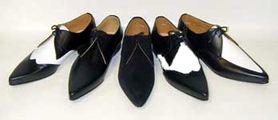 "Well, sharp toed and high heeled and a buckle on the side
"Well, sharp toed and high heeled and a buckle on the side
Zip 'em up and lace 'em up in any old style
I won't have to worry who's stepping on my blues
A keen cutting cat with my pointed toe shoes
[Chorus]
I said, pointed toes are coming back again
Ah-ah-ah, pointed toes are coming back again
Well, everything's alreet
When I got 'em on my feet
I said, the point's coming back again"
Today, Winklepickers are considered gothic and only goths wear them.
We predated Nikes. We predated leather athletic shoes. All soft shoes were "tennis shoes" or "gym shoes", and all were canvas. They were used in gym class or after school athletics. They were never worn to class. And guys wore high-tops and girls wore low-cuts, otherwise you would have been be considered a transgender. About the only canvas shoes left are Converse All Stars.
 You could buy shoes (not loafers) that didn't have laces. They were called flapjacks.
The tongue was on the outside and slid up on a pair of wires and
locked the shoe onto your feet. In the late fifties, velcro fasteners showed up,
but that didn't cut it with a lot of kids because they weren't strong enough to
stand up to the rigors of dancing.
You could buy shoes (not loafers) that didn't have laces. They were called flapjacks.
The tongue was on the outside and slid up on a pair of wires and
locked the shoe onto your feet. In the late fifties, velcro fasteners showed up,
but that didn't cut it with a lot of kids because they weren't strong enough to
stand up to the rigors of dancing.
Bobby socks.
Socks were always folded down at the top.
If a guy wore a shirt or jacket, it was mandatory to turn the collar up in the back.
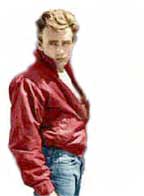 Prior to 1955, guys wore slacks and dress shirts to school. On October 29, 1955,
the movie “Rebel Without A Cause” opened at the Astor Theater in New York. In the
opening scenes, James Dean wore slacks and a dress shirt, but as his rebellion grew
he switched to jeans, a white T-shirt, and a bright red windbreaker, and suddenly
every teenage boy in America was doing the same. There was such a run on jeans that
Levi Strauss and Company ran short of supply, and you couldn’t buy a white T-shirt
or red windbreaker anywhere. No other movie has had such an instantaneous impact
on American fashion.
Prior to 1955, guys wore slacks and dress shirts to school. On October 29, 1955,
the movie “Rebel Without A Cause” opened at the Astor Theater in New York. In the
opening scenes, James Dean wore slacks and a dress shirt, but as his rebellion grew
he switched to jeans, a white T-shirt, and a bright red windbreaker, and suddenly
every teenage boy in America was doing the same. There was such a run on jeans that
Levi Strauss and Company ran short of supply, and you couldn’t buy a white T-shirt
or red windbreaker anywhere. No other movie has had such an instantaneous impact
on American fashion.
Faded jeans were an abomination because they implied that you were poor. Faded jeans did not become fashionable until the sixties, when the hippies made being poor fashionable.
No T-shirt had pockets, so the guys who smoked rolled a pack of cigarettes up in one of the sleeves of their white T-shirt. Today, all of my T-shirts have pockets. I need the pocket for my bifocals.
You could tell the hot rodders because they didn't wear their belt buckles in the front. They wore the buckles between the first and second belt loop on the right or left. So the belt buckle wouldn't scratch the paint when they were working on their car.
A dressed up kind of a guy: black shirt, black slacks, thin white belt, white bucks, pink tie.
Narrow knit ties.
Half-inch wide belts for guys, four-inch wide belts for girls.
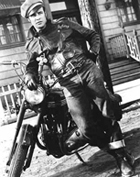 When we bought jeans, we got them extra long, and rolled the legs up into cuffs.
We needed enough length for two rolls, and a minimum two-inch cuff. Check out Marlon
Brando in "The Wild One" at the right.
People who observe fifties fashions today think this was only the style, but
there was a compelling non-fashion
reason for this. We preceded pre-shrunk materials. Cotton went straight from the gin
to the mill and loom, and so if we didn't buy jeans
that were five times too long, when we washed them a couple of times they
were up to our knees. If that happened, our parents would have had to kill us,
because nobody would have ever gone into a school building wearing Little Lord
Fauntleroy jeans. We could, and did, wear cuffless jeans once they had been washed
enough times that a cuff wasn't necessary. But the rule for boys was that they had to
touch the tops of your shoes. Girls' jeans went higher, above the ankle. It was good to
show a little ankle.
When we bought jeans, we got them extra long, and rolled the legs up into cuffs.
We needed enough length for two rolls, and a minimum two-inch cuff. Check out Marlon
Brando in "The Wild One" at the right.
People who observe fifties fashions today think this was only the style, but
there was a compelling non-fashion
reason for this. We preceded pre-shrunk materials. Cotton went straight from the gin
to the mill and loom, and so if we didn't buy jeans
that were five times too long, when we washed them a couple of times they
were up to our knees. If that happened, our parents would have had to kill us,
because nobody would have ever gone into a school building wearing Little Lord
Fauntleroy jeans. We could, and did, wear cuffless jeans once they had been washed
enough times that a cuff wasn't necessary. But the rule for boys was that they had to
touch the tops of your shoes. Girls' jeans went higher, above the ankle. It was good to
show a little ankle.
Hoop skirts, and poodle skirts, and three-foot-wide mesh petticoats.
A neck scarf went with the poodle skirt, with the knot tied on the side.
Playtex Girdles. With garters. Pantyhose didn’t show up until the 1960s when hemlines went up.
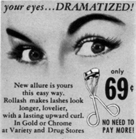 Every bathroom had one of those doohickys on the right. I discovered my first one
when I was about seven. I also discovered that they were no good for clipping toenails
or sharpening pencils, and that after I tried those they were also no good for
curling eyelashes.
Every bathroom had one of those doohickys on the right. I discovered my first one
when I was about seven. I also discovered that they were no good for clipping toenails
or sharpening pencils, and that after I tried those they were also no good for
curling eyelashes.
"Lipline" lipstick.
"Mink" face powder.
White lipstick. White eyeshadow.
Tangee Lipstick, "The orange-in-the-tube lipstick that changes color to become uniquely your own."
Eyebrows that were first shaved then penciled back in!
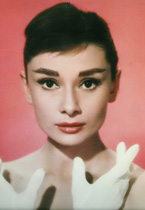 Doe eyes. What are they? Well, Audrey Hepburn had them. But it was a makeup effect.
Here's how: "Line the entire top lash line and extend the line slightly at the corners.
Also line the bottom of the eyes, but concentrate color only on the outer third and
extend it slightly past the edge. Don't overdo it ala Elizabeth Taylor in Cleopatra.
A soft, smoky look will open the
eyes more than a thin, hard line. Use only dark, neutral colors with a hint of black
for lining, as bright shades will only make eyes seem smaller. Curl lashes three times
before applying mascara. Start at the base, halfway up and at the tip to create a gentle,
rounded curl. Fan out lashes while applying mascara. Brush the inner third in toward the
nose, the middle third straight out and the outer third toward the temples.
Use only light-colored shadows, darker ones will diminish the effect.
Brush a subtle base color from lash to brow,
and then use a slightly darker shade to create subtle definition in the crease."
Got that?
Doe eyes. What are they? Well, Audrey Hepburn had them. But it was a makeup effect.
Here's how: "Line the entire top lash line and extend the line slightly at the corners.
Also line the bottom of the eyes, but concentrate color only on the outer third and
extend it slightly past the edge. Don't overdo it ala Elizabeth Taylor in Cleopatra.
A soft, smoky look will open the
eyes more than a thin, hard line. Use only dark, neutral colors with a hint of black
for lining, as bright shades will only make eyes seem smaller. Curl lashes three times
before applying mascara. Start at the base, halfway up and at the tip to create a gentle,
rounded curl. Fan out lashes while applying mascara. Brush the inner third in toward the
nose, the middle third straight out and the outer third toward the temples.
Use only light-colored shadows, darker ones will diminish the effect.
Brush a subtle base color from lash to brow,
and then use a slightly darker shade to create subtle definition in the crease."
Got that?
Pedal pushers (Capris).
Sack dresses. Introduced in 1957, from which would evolve sheath dresses, shift dresses, shirt-waister dresses, and sweater dresses.
Wrap-around skirts. Culottes.
Bikinis were things that French girls wore on the Riviera far, far away. Our girls wore bathing suits that looked like painted girdles.
At the tail end of Mabelvale's tenure as a high school, 1966, came the fashion statement that (some declared) would spell the "doom of the very moral fiber of America". The miniskirt was introduced by Mary Quant, who later would give us the micro-miniskirt, plastic raincoats, and hot pants.
Poodle cuts and French pleats.
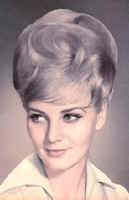 Beehive hairdos (classified as an “updo”, though there were other updo styles).
The story persisted that a local high
school girl passed out in class and her teacher noticed blood running down her neck.
Turns out she had a family of spiders living in her ‘do. Or sometimes it was
cockroaches. Same story is still around, only now it’s about dreadlocks.
Beehive hairdos (classified as an “updo”, though there were other updo styles).
The story persisted that a local high
school girl passed out in class and her teacher noticed blood running down her neck.
Turns out she had a family of spiders living in her ‘do. Or sometimes it was
cockroaches. Same story is still around, only now it’s about dreadlocks.
Big, big hair curlers, AKA rollers, to maintain an updo. Early ones were metal with the brown brushes inside, then later, pink plastic. Around 1960, Coke, Royal Crown Cola, and other soft drinks began appearing in steel cans and some girls actually used empty cans for hair rollers. Chiropractors did a booming business treating girls who tried to sleep with the curlers in place. Here's how to get ready to go out in public with the big, big hair curlers still attached: tie a scarf around the curlers by first folding the scarf into a "V" shape, then put it around the back of your head, using bobby pins to secure it on the side, then pull it back around and tie it in the front. Top it all off with black pedal pushers, a man's shirt tied in a knot at the bottom, and a pair of stilettos and, honey, head out for Kroger's.
Ponytails.
Bows. To make the ponytails stay up.
Ducktails and sideburns.
Brylcreem ("Brylcreem -- A Little Dab'll Do Ya!"), to make the ducktail stay put. Brylcreem was Crisco in a tube. Vitalis was useless for this task, because it was just scented alcohol. Which was the biggest seller? Well, the name of the musical was “Grease”, not “Alcohol”.
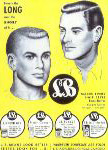 At the other extreme, flat tops, and in the same breath, Lucky Tiger Cru-Butch Wax.
Except at barber shops where the preferred brand was LB, which wasn't
available in retail stores.
At the other extreme, flat tops, and in the same breath, Lucky Tiger Cru-Butch Wax.
Except at barber shops where the preferred brand was LB, which wasn't
available in retail stores.
Aqua Velva, or Eau Sauvage, or Jade East, or maybe the Old Spice you got for Christmas.
Jungle Gardenia, or maybe Intimate, or Tabu, or Evening In Paris, or To A Wild Rose. And, of course, Chanel Number Five.
Pop beads.
Soap on a rope.
 Winged, or cat's eyes, eyeglasses, the kind the old lady always wears in the “Far Side” cartoons.
Winged, or cat's eyes, eyeglasses, the kind the old lady always wears in the “Far Side” cartoons.
Hey guys, did you ever own a gen-u-wine Davy Crockett coonskin hat? Of course you did.

